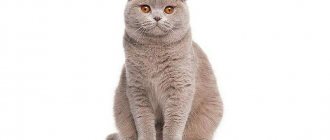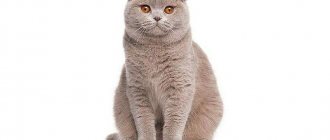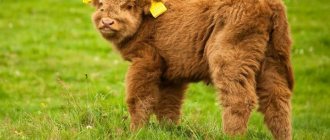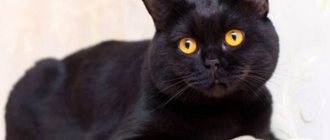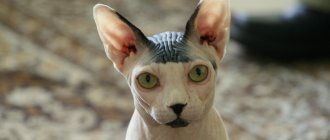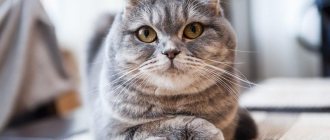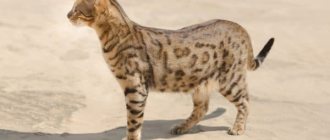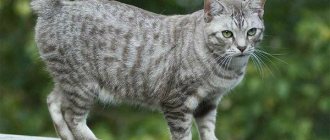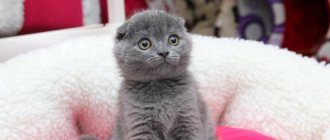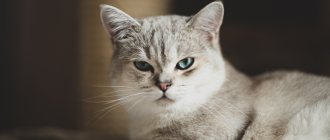The appearance of this cat immediately attracts attention - the “fatal” color combined with unusual honey-amber eyes. At first glance, this cute animal with a funny round face and plush fur seems affectionate and calm. In fact, they are active, inquisitive and friendly.
Let's find out how the black fold cat differs from representatives of other breeds and whether there are any peculiarities in its maintenance.
The appearance of fold-eared cats
Scottish cats with the tips of their ears downward are a unique phenomenon in nature. Such a mutation has not appeared in any other breed. Although there is still an American curl, whose ears are bent in the opposite direction. But it was bred later in another part of the world.
The Scottish Fold appeared relatively recently. In 1961, an American farmer discovered a white cat with an unknown natural mutation. The animal's ears dropped down and covered part of the ear canal. Later, this cat gave birth to offspring, and two of her kittens were also fold-eared.
The male kitten was castrated at an early age and did not participate in breeding. And his little sister was acquired by William Ross, a great lover of cats and a fan of everything unusual. He decided to develop a new breed, attracted geneticist Pat Turner to the idea, and they developed a breeding program for a new species.
As a result of matings with British and American shorthairs, 76 babies were born in 3 years from the daughter of the first fold cat. 34 of them had normal ears, and 42 kittens were born with a hereditary genetic trait. Subsequently, the experimenters had to solve problems with the health of the offspring.
It turned out that cats with a homozygous combination of Fd Fd suffer from diseases of the musculoskeletal system that cannot be treated. Later, scientists found the heterozygous formula Fdfd and the risk of pathology decreased significantly.
All Scottish cats are divided into 2 groups, each of them has straight-eared and fold-eared cats:
- longhaired Highland Fold and Highland Straight;
- shorthaired Scottish Fold and Scottish Straight.
Straight-eared Scottish cat
The Scottish cat breed has been recognized by most international felinological organizations and now takes part in the most prestigious exhibitions.
Appearance
Light blue coat color is considered classic. But since a large number of different exotics took part in the formation of the breed, today a huge variety of colors is acceptable. Scots can be blue, cream, white, bicolor, black, tabby, chinchilla and so on.
The head of animals of this breed is round, with a flat forehead, drooping ears. The legs are relatively short, the paws are rounded. The nose is straight and wide. The fur is short and thick.
On average, a black fold cat weighs 8 kg.
Features of color
Ancient cats had several color options. Felinologists associate this phenomenon with the natural need to camouflage during hunting. Later, when animals became domesticated and began to live next to humans, the number of color combinations increased due to interbreeding.
Eumelanin, a high-molecular pigment with a complex chemical formula and irregular structure, is responsible for the formation of the charcoal shade. As part of cat hair, it is represented by spherical granules that absorb the color spectrum as much as possible. They are evenly located along the entire length of the hair and color it from the root bulb to the very tip.
It is very difficult to get a beautiful black color in fold-eared cats. The color is traditionally “capricious” and often takes on extraneous shades. This is especially true for animals with thick undercoat. It becomes covered with reddish “rust” or piebald gray hair, which noticeably detracts from the spectacular appearance of the black coat.
Another problem in obtaining a pure black color in fold-eared cats is the presence of additional derivatives of the eumelanin pigment: brown and cinnamon (cinnamon). If the selection of partners for mating is incorrect, these shades affect the process of color formation.
In natural breeds, brown color is extremely rare, but Scots do not belong to the group of aboriginal cats and therefore have a very high risk of such a transformation.
But in its pure form, black eumelanin provides some benefits for a cat's appearance:
- The wool gains mechanical strength - the pigment strengthens the hair.
- Chemical treatment does not affect eumelanin; it is resistant to aggressive environmental influences and is not dissolved by organic compounds.
This is interesting! In England, black cats are not viewed with suspicion. They are believed to bring good luck to the home and even help women in love.
Genetics of black color
If, on the part of pigments, only one element (eumelanin) affects the color of black Scottish fold cats, then several components take part in genetic engineering.
- The main dominant gene for black color is B. In various combinations of alleles, it can turn into bb (chocolate color) or b1b1 (cinnamon color).
- The agouti gene in the dominant state A forms the pattern on the coat, and in the recessive state aa gives a solid color. For a black or black and white fold cat, this item usually takes the recessive form aa. Although the pattern is not visible on the main color, the white areas are characterized by a complete absence of pigment and also do not react to agouti. But for brown and cinnamon animals, gene A is very important.
- Tabby (T) is a pattern on the coat; it can take the form of stripes, spots, and ripples. Totally depends on the agouti.
- Gene D. In the dominant state, the color remains unchanged, and in the recessive state, dd lightens it by several tones. For example, in a Scottish fold black and white cat, the main color will be replaced by blue.
The genetic formula for the ideal solid black color in the Scots is expressed as follows -aaB-D- (no agouti/black/no bleaching).
Additional genetic “components” take part in the formation of bicolors (a combination of the main color and white).
- Option Ss – bicolor. Under normal conditions, the proportion of colors is approximately 30:70.
- Sisi combination – white spots (buttons, medallions).
- Van color – Sw. In this black and white version, the Scottish Fold cat is colored dark on the tail and in the ear area, while the rest of the coat remains light.
Eye color
The influence of coat color genes on eye color has not yet been established. Scientists believe that so-called polygenes complicate matters here. They give instructions simultaneously to several hereditary characteristics, both hidden and obvious. Eye color in cats falls precisely into this section.
The animal does not have any separate genetic instructions from the parental set of chromosomes, but from generation to generation it duplicates the same characteristics.
Black Scottish Fold cats traditionally have copper or honey-amber irises. Green color is also allowed in native breeds, but Scots do not belong to this group.
Important! The color of the nose and paw pads depends on the shade of the coat. For black Scottish Folds, they should be the main color.
When does eye color change occur?
Each cat breed changes eye color at certain times. Most often it occurs between 2 weeks and 12 months after the eyes begin to open. A kitten's eye color changes gradually. Two weeks after birth, the eyes are covered with a cloudy film. Because of this, they appear to have a gray tint. And only then the shade becomes more pronounced. From this moment you can approximately determine what eye color will be. However, you cannot be sure of this, since the range of shades is very large - from a gray-blue tint to brown. Therefore, those who get a purebred kitten and want it to have a particular eye color most often adopt it at the age of 4 months.
It is worth noting that if the kitten initially had yellow eyes, then this color becomes brighter - amber, copper or golden. That is, brown eyes can never acquire a blue tint.
Grooming
The black and black-and-white coats of Scottish Fold cats are resistant to color fading. It is not affected even by direct sunlight, which in other cases discolors the color or gives it an extraneous tint. The black color enhances the strength of the hair, which also has a positive effect on the quality of the coat and its appearance.
Hygiene for black fold cats comes down to regular brushing and keeping the mucous membranes clean.
- In normal times, it is enough to treat the wool twice a week. It is advisable to accustom black fold kittens to this procedure from childhood, so that in the future they do not perceive combing as a punishment.
- The active period of shedding makes it necessary to use a comb daily, and for semi-long-haired Scottish Fold black and white Highland Folds - several times a day.
- The nose and area around the eyes are cleaned as they become dirty.
- Ear hygiene. Care must be taken not to damage weak cartilages. Veterinarians also recommend using special drops and lotions that neutralize wax deposits in the ear canal.
Free photo: red cat, green eyes, feline.
Image type, jpg. Resolution, 2000×1500. Uploaded August 24, 2016 Category: Animals. Views, 638. Number of downloads, 37.
Beautiful pictures of cats.
A ginger cat with green eyes looks especially good against a golden background. The highlight of the picture is the light green butterfly. Red cat with green eyes.
Character and temperament
All varieties of the breed, from black straight cats to the more common gray fold-eared Scottish cats, are characterized by the same character traits.
- They are all kind and affectionate - the Scots are not characterized by aggression and rancor.
- These cats are calm and balanced; natural arousal is recorded only during sexual activity or in the late stages of pregnancy.
- Sociability and loyalty to family members and pets are at the highest end of the measurement scale.
- Good learning ability - Scots are able to remember acquired knowledge for a long time.
- Unpretentiousness in food and living conditions.
Scottish Folds love active games, enjoy general walks and are always ready to keep a person company.
Socialization
These animals get used to their family extremely quickly. Experienced owners are sure that cats treat children and elderly family members with special tenderness. If they really like a person, they will follow him everywhere, trying to attract attention. However, no matter how much they want to socialize, they will not distract from business by grabbing your legs or jumping on your lap. The most important thing for these cats is to be close to their loved one.
Other animals, including cats, please the Scots as they love good company. Even living together with a dog does not spoil the cats’ mood - they quickly get used to such a neighbor, playing with him and even caring for his fur.
Beliefs and signs about black cats
In England, where the lineage of fold-eared cats began, the attitude towards black animals is completely different from how they are perceived in eastern countries.
- In Scotland, meeting a black cat is considered a good omen.
- If a black cat enters someone else's house, it means that a happy surprise awaits its owners. This has been believed in the English provinces for many centuries. Therefore, a saucer of milk is often left near the house in case an unfamiliar four-legged guest arrives.
- Black cats are highly prized by British sailors. Since ancient times, such animals have been considered the best rat catchers. For the same reason, farmers selected black cats.
- For the fair sex, a black cat attracts suitors to the house and increases the girl’s chances of a successful marriage.
The black fur of fold-eared cats has not become the subject of a negative reputation for these cats. They look too funny to inspire fear or apprehension when you meet them. With good heredity and proper maintenance, Scots live up to 15 years.
They delight others with their gentle character, good disposition, sociability and impeccable politeness, which is inherent in real Englishmen.
Diseases
Owners need to take care of the health of a cat prone to longevity. Despite the fact that the average lifespan of a lop-eared cat is 19 years, you need to regularly take them to the veterinarian and monitor their well-being at home.
First of all, you should monitor the cat’s appetite, sociability and behavior. If there are warning factors, it is necessary to check the temperature, take the pulse, and pay attention to other symptoms. If something bad happens to your animal, you should immediately consult a doctor.
How to choose a Scottish Straight kitten
Arm yourself with the breed standard and visit a Scottish Straight breeder in an informal setting to see with your own eyes the conditions in which the kittens grow up. Well-groomed Scottish dogs have lush, shiny coats and clear, open eyes. The abdomen of a normally developing baby is soft, and not swollen to the point of a ball. A healthy kitten's tail should be clean, and its fur should not smell bad or sparkle with bald spots.
Observe the behavior of the young Scottish Straight. A trouble-free baby willingly joins in the gameplay and shows interest. Kittens that are bored and unresponsive are most likely unhealthy or depressed. Observing the character of the babies’ parents is also a good safety net, since it is from them that the animals inherit their temperamental characteristics.

